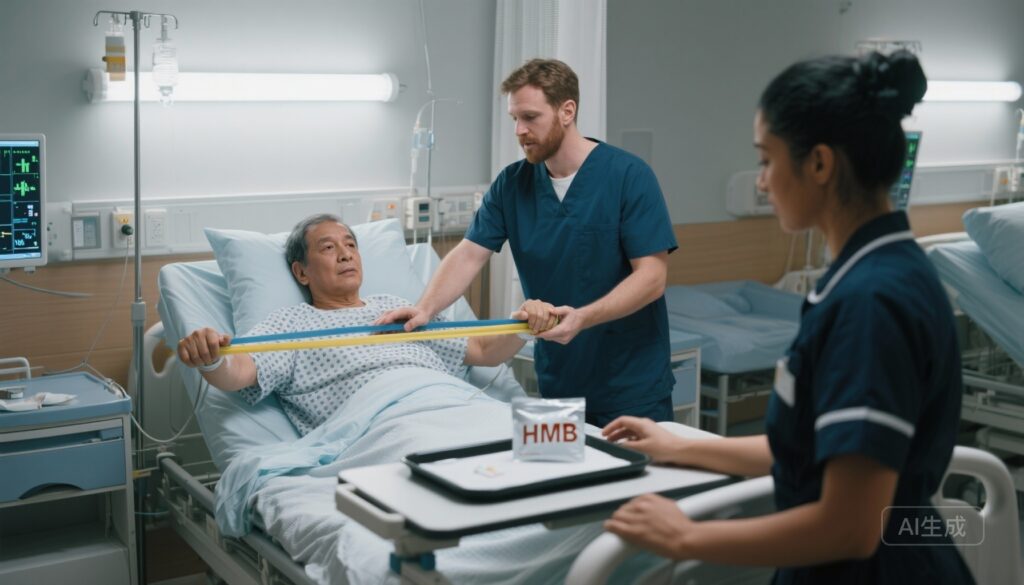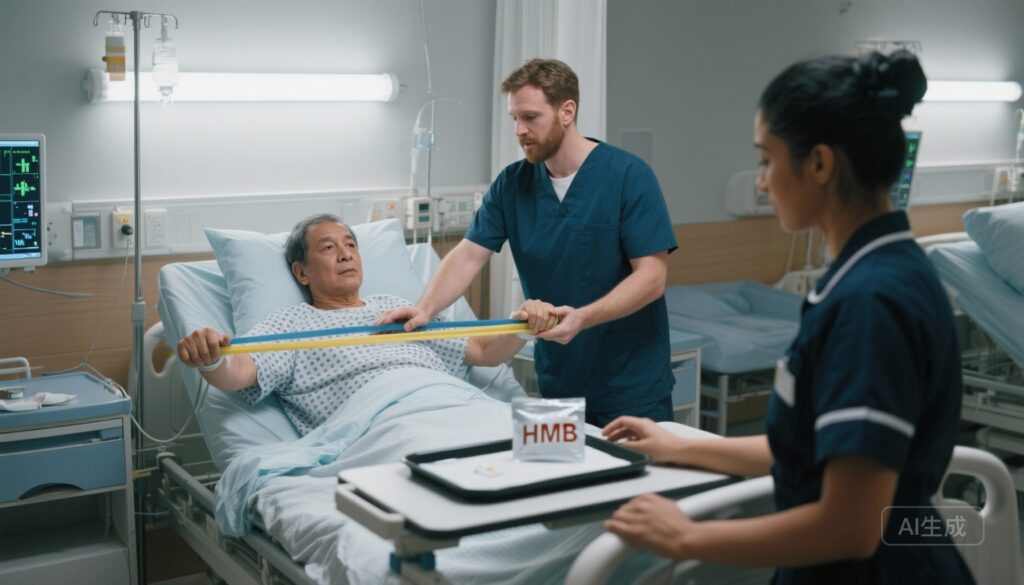Highlight
– In a multinational randomized 2 × 2 factorial trial (n=266), resistance training (RT) started in the ICU and continued until discharge significantly improved discharge physical function (SPPB and 6MWD), increased muscle mass and strength, reduced patient‑reported fatigue and psychological symptoms, and was associated with lower 6‑ and 12‑month mortality.
– β‑hydroxy‑β‑methylbutyrate (HMB) produced only modest improvements in phase angle and fatigue and did not enhance the effects of RT; no interaction between RT and HMB was detected.
– Results support integrating structured resistance exercise into early rehabilitation for selected critically ill patients; routine HMB supplementation is not supported by these findings.
Background and clinical context
ICU‑acquired weakness and prolonged physical impairment are common consequences of critical illness and ICU care. Survivors frequently experience persistent muscle wasting, reduced functional capacity, fatigue, depression and poor sleep — problems that contribute to decreased quality of life and increased healthcare utilization. Combinations of nutritional and rehabilitative interventions have long been prioritized as potential strategies to attenuate muscle loss and accelerate functional recovery, but evidence for optimal approaches remains limited. The trial by Wu et al. tested two promising, complementary interventions: bedside resistance training (RT) initiated during critical illness, and oral β‑hydroxy‑β‑methylbutyrate (HMB), a leucine metabolite with anabolic and anti‑catabolic properties.
Study design and methods
Wu et al. conducted a multicenter, open‑label, 2 × 2 factorial randomized controlled trial with blinded outcome assessment in 266 adult ICU patients (ChiCTR2200057685). Participants were randomized to one of four groups: RT alone, HMB supplementation alone, both RT and HMB, or standard care. Interventions began in the ICU and continued until hospital discharge. Primary outcomes measured at discharge were 6‑minute walk distance (6MWD) and the Short Physical Performance Battery (SPPB). Secondary outcomes included muscle strength (grip strength), muscle mass (appendicular skeletal muscle mass, skeletal muscle index), patient‑reported outcomes (fatigue, sleep quality, psychological symptoms, cognition, quality of life), phase angle (bioelectrical impedance), and mortality at 1, 6 and 12 months. Analyses were intention‑to‑treat and used linear mixed‑effects models to estimate independent and interaction effects of RT and HMB.
Key findings
The trial provides a comprehensive set of functional, physiologic, patient‑reported and survival outcomes. Key results (as reported) are:
Primary outcomes (discharge)
– Resistance training vs no RT: SPPB increased by a mean difference of 1.32 points (P = 0.003). 6MWD increased by 56.20 meters (P < 0.001). These improvements are clinically meaningful: SPPB changes >1 point often reflect perceptible functional gains, and a ~50 m increase in 6MWD is substantial in a debilitated population.
Muscle mass and strength
– RT was associated with higher grip strength (mean difference 3.19 kg; P = 0.008).
– Appendicular skeletal muscle mass increased by 0.997 kg with RT (P = 0.005).
– Skeletal muscle index rose by 0.428 kg/m2 (P = 0.025).
Patient‑reported outcomes
– RT reduced fatigue and improved sleep quality and psychological symptoms (all P < 0.05). RT had no detectable effect on cognition or overall health‑related quality of life at discharge.
Mortality
– RT was associated with reduced odds of death at 6 months (OR 0.51; P = 0.011) and 12 months (OR 0.55; P = 0.014). These are important and somewhat unexpected findings, suggesting that in‑ICU RT may confer durable survival benefit beyond functional restoration.
HMB supplementation
– HMB modestly increased phase angle (0.367; P = 0.020) and reduced fatigue (–1.069 points; P = 0.005), but produced no benefit for functional endpoints, muscle mass, strength or mortality. Hyperglycemia occurred in 3 of 134 patients receiving HMB. No significant interaction between RT and HMB was observed, indicating absence of synergy when combined.
Safety
The safety signal was favourable overall. Hyperglycemia in three HMB recipients was noted; otherwise no major adverse events attributable to interventions are reported in the summary. An open‑label design means some non‑physiologic outcomes could be influenced by co‑interventions, but blinded outcome assessment mitigates observer bias for primary measures.
Interpretation and clinical implications
These results support several practical conclusions. First, structured resistance training that begins in the ICU and continues through hospital discharge can produce rapid, clinically meaningful gains in physical performance (SPPB, 6MWD), measurable increases in muscle mass and strength, and improvements in fatigue, sleep and psychological symptoms. Most strikingly, RT was associated with substantial reductions in medium‑term mortality (6 and 12 months), findings that — if confirmed — would elevate early resistance training from a rehabilitative adjunct to an intervention with survival benefit.
Second, routine HMB supplementation in this setting appears to offer only modest physiologic benefit (higher phase angle) and small symptom relief for fatigue without improving functional outcomes or survival. The absence of interaction suggests HMB does not potentiate the effects of resistance training in critically ill patients.
Biological plausibility
Resistance exercise stimulates muscle protein synthesis, reduces proteolysis, preserves neuromuscular function and improves insulin sensitivity. During and after critical illness these effects can counteract the catabolic stress response and promote recovery of functional capacity. HMB has been shown in non‑critically ill populations to augment muscle protein synthesis and attenuate breakdown; however, the biologic milieu of critical illness — systemic inflammation, immobility, altered nutrient utilization — may limit its efficacy. The relatively rapid and broad benefits observed with RT are consistent with the central role of mechanical loading in maintaining muscle mass and function.
Strengths and limitations
Strengths of the trial include randomized factorial design, multicenter recruitment, blinded outcome assessment, comprehensive outcome set spanning physiology, function, patient‑reported measures and mortality, and intention‑to‑treat analysis. The factorial design efficiently evaluated independent and combined effects of RT and HMB.
Limitations include the open‑label delivery of interventions, which could influence co‑care (though primary outcomes were assessed blinded). Generalizability requires caution: population characteristics, ICU staffing, rehabilitation expertise and nutrition practices in participating centers may differ from other settings. The summary does not detail adherence rates, exact RT protocols (frequency, intensity, progression), or HMB dose and formulation; these are crucial to translate findings into practice. Finally, despite randomized allocation, residual confounding or imbalances could influence mortality results; replication is needed before practice‑changing recommendations.
How this fits into current practice and research priorities
The trial addresses a priority area in critical care survivorship: combined nutrition and rehabilitation. Unlike many previous studies that focused on early mobility without clear strength or anabolic components, this trial targeted resistance training — the modality most directly linked to muscle hypertrophy and strength. The robust functional and survival signals should prompt ICU teams and institutions to consider structured RT programs for eligible patients, while awaiting confirmatory trials and operational guidance on program delivery, patient selection and resource needs.
Regarding HMB, the data argue against routine supplementation in the absence of demonstrated functional or survival benefit. HMB may be considered in select cases for symptom relief or when phase angle improvement is desired, but clinicians should weigh potential hyperglycemia risk and cost.
Unanswered questions and research gaps
Important remaining questions include: Which patient subgroups derive the greatest benefit (age strata, baseline frailty, severity of illness)? What are the minimal effective RT dose, timing, and progression parameters that balance efficacy and safety? Can the mortality benefit be replicated and mechanistically explained? What is the optimal nutritional context for exercise (protein dose, timing) and are there other supplements that synergize with RT? Cost‑effectiveness and implementation research are needed to translate trial findings into routine ICU practice.
Conclusion
The multicenter 2 × 2 factorial randomized trial by Wu et al. (Crit Care. 2025;29:438) provides compelling evidence that bedside resistance training started in the ICU and continued to discharge improves functional outcomes, increases muscle mass and strength, reduces fatigue and psychological symptoms, and is associated with lower 6‑ and 12‑month mortality. HMB supplementation produced modest physiologic and symptomatic effects but did not improve functional outcomes or survival and did not enhance RT. These findings support prioritizing structured in‑ICU resistance training as part of rehabilitation pathways for appropriate patients while indicating that routine HMB supplementation is unlikely to yield major clinical benefit. Replication, detailed protocol dissemination, and implementation studies are now important next steps.
Funding and trial registration
Trial registration: ChiCTR2200057685 (https://www.chictr.org.cn/), registered March 15, 2022. Full citation: Wu T, Wei Y, Xiong J, Wu J, Lin X, Zhuang Y, Luo C, Xu M, Chen X, Lin Z, Li H. Resistance training and β‑hydroxy‑β‑methylbutyrate for functional recovery in critical illness: a multicenter 2 × 2 factorial randomized trial. Crit Care. 2025 Oct 16;29(1):438. doi: 10.1186/s13054-025-05660-9. PMID: 41102810; PMCID: PMC12532832.
References
Wu T, Wei Y, Xiong J, et al. Resistance training and β‑hydroxy‑β‑methylbutyrate for functional recovery in critical illness: a multicenter 2 × 2 factorial randomized trial. Crit Care. 2025;29:438. doi:10.1186/s13054-025-05660-9.




